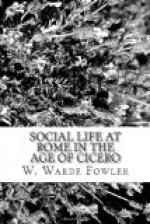Among the old gilds were also those of the smiths (fabri ferrarii) and the potters (figuli), but of these little need be said here, for they were naturally fewer in number than the vendors of food and clothing, and the raw material for their work had, in later times at least, to be brought from a distance. The later Romans seem to have procured their iron-ore from the island of Elba and Spain, Gaul, and other provinces,[91] and to have imported ware of all kinds, especially the finer sorts, from various parts of the Empire; the commoner kinds, such as the dolia or large vessels for storing wine and oil, were certainly made in Rome in the second century B.C., for Cato in his book on agriculture[92] remarks that they could be best procured there. But both these manufactures require a certain amount of capital, and we may doubt whether the free population was largely employed in them; we know for certain that in the early Empire the manufacture of ware, tiles, bricks, etc., was carried on by capitalists, some of them of noble birth, including even Emperors themselves, and beyond doubt the “hands” they employed were chiefly slaves.[93]
But industries of this kind may serve to remind us of another kind of employment in which the lower classes of Rome and Ostia may have found the means of making a living. The importation of raw materials, and that of goods of all kinds, which was constantly on the increase throughout Roman history, called for the employment of vast numbers of porters, carriers, and what we should call dock hands, working both at Ostia, where the heavier ships were unladed or relieved of part of their cargoes in order to enable them to come up the Tiber,[94] and also at the wharves at Rome under the Aventine. We must also remember that almost all porterage in the city had to be done by men, with the aid of mules or donkeys; the streets were so narrow that in trying to picture what they looked like we must banish from our minds the crowds of vehicles familiar in a modern city. Julius Caesar, in his regulations for the government of the city of Rome, forbade waggons to be driven in the streets in the day-time.[95] Even supposing that a large amount of porterage was done by slaves for their masters, we may reasonably guess that free labour was also employed in this way at Rome, as was certainly the case at Ostia, and also at Pompeii, where the pack-carriers (saccarii) and mule-drivers (muliones) are among the corporations of free men who have left in the form of graffiti appeals to voters to support a particular candidate for election to a magistracy.[96]




